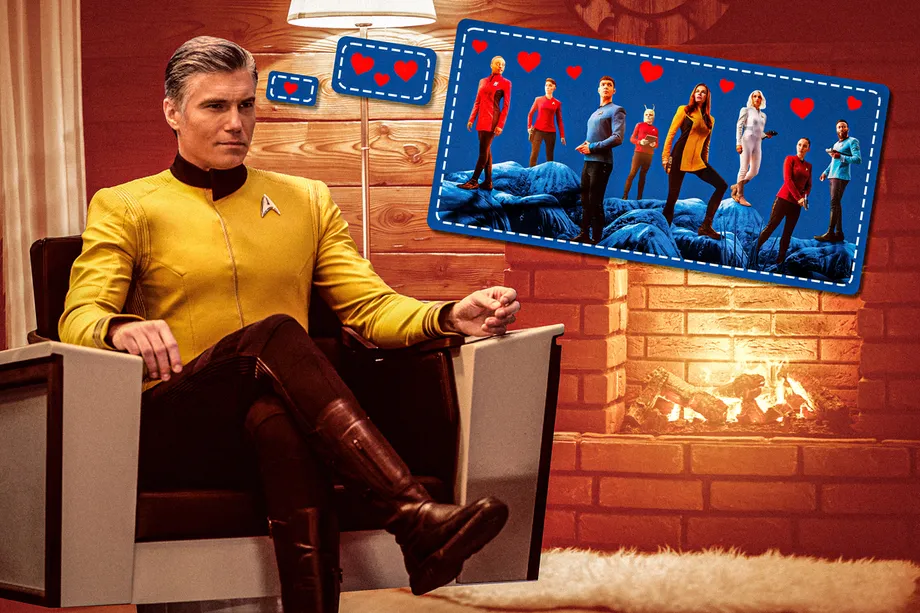There are always cheerful flames flickering on the hearth in Captain Pike’s cabin on the Enterprise of Star Trek: Strange New Worlds. Often he has guests—crewmates and confidantes who’ve flocked to those flames, and to the warmth of their captain’s company. At Pike’s collegial Round Table, the dress code is casual, rank is irrelevant, and even ensigns speak freely. Sometimes the captain cooks, eschewing the ease of the replicator in favor of the human, homemade touch. (The man makes a mean waffle.) Then he does dishes, an apron protecting the uniform that he has to keep pristine in case a priority one message from Starfleet interrupts the bull session and beckons the captain to the bridge. The vibe and decor in Pike’s quarters are retrofuturistic—sleekness and swank crossed with common-room hominess. It’s my 2022 TV happy place. I want to boldly go to there.
The greatest strength of Strange New Worlds is that I wouldn’t mind if that summons from Starfleet never came. As far as I’m concerned, the Enterprise could crawl along at the slowest warp factor, ferrying fuel to a distant base or mapping some new star system, if it meant more time to hang with my new Star Trek TV dad and his merry band of best friends/loyal lieutenants. Yellow alert? More like mellow alert. The series’ first season has been over for only a few hours—its 10th and final episode was released on Thursday—but I already miss my adopted, 23rd-century sci-fi family. “I hate goodbyes,” Uhura says in the season’s penultimate episode, echoing the sentiments of most of the series’ audience. Even knowing that production on the second season has already wrapped, it’s hard to disengage from a show whose comforting familiarity belies its title. After finishing the finale, I felt like a kid reluctantly returning to real life after an extended stay at space camp. Is it possible to feel homesick for a fictional starship?
Unlike The Next Generation or Deep Space Nine, Strange New Worlds didn’t start at sublight speed. The series was fully formed and functional from the get-go, partly because it relies on some legacy characters and because it spun off from the second season of Discovery, a series that leaped far into the future and, in the process, ran off the rails after parting ways with Pike and Co. Small-screen Star Trek has arguably never been better than this: Even before the finale, Strange New Worlds had garnered both near-unanimous critical acclaim and the highest average IMDb user rating of any live-action season in franchise history. (Its rating was tied, perhaps only temporarily, with that of the also-excellent second season of the animated Lower Decks.)
It helps, of course, that the era of shorter TV seasons has spared Strange New Worlds the need for fluff and padding that caused the quality of its predecessors to fluctuate wildly from week to week. Keep only the top 10 installments from one of TOS, TNG, or DS9’s 26-episode seasons, and those shows would’ve had higher average ratings, too. In that sense, then, Strange New Worlds is, like its captain and its version of the Enterprise, an ideal blend of old and new: the episodic structure of OG Trek, coupled with the quality control of a more manageable streaming season.
Strange New Worlds squeezes a more extended season’s worth of extrasolar exploration, adventure variety, and fleshed-out characterization into its reduced screen time. As advertised, there are, in fact, some strange new worlds; the Enterprise is the only constant in the peripatetic series’ exotic tapestry of settings. The ship’s travels bring our heroes face-to-face and antennae-to-antennae with an assortment of Star Trek tropes, including but not limited to unending wars resolved by playing fast and loose with General Order 1; mysteriously sentient space entities; deserted or distressed colonies; deceptive distress calls; insidious, parasitic infections; elaborate fantasy scenarios constructed by telepathic, incomprehensibly powerful beings; body swaps, and time travel.
More exciting than the changes of scenery and the variety in mission objectives, though, is the elasticity of the series’ tone, which ranges from the tense naval combat of “Memento Mori” to the comic relief of “Spock Amok,” the poignant playfulness of “The Elysian Kingdom,” and the Alien-inspired horror of “All Those Who Wander.” It’s hard to provide a capsule summary of a standard Strange New Worlds episode, save for the fact that it’s unfailingly rooted in classic Star Trek optimism and in the bonds between crew members, whose personal and professional lives intertwine during their long-term mission.
If there’s a criticism that could be levied against the series—aside from its regrettable lack of nonhuman leads—it’s that Strange New Worlds is more of a Star Trek remix than the new frontier for the franchise that the poster promised. Pike incorporates aspects of other Trek captains; his crew includes characters from other Trek crews; and their adventures often hearken back to other Trek episode plots. Yet the ingredients are mixed in such a sublime, loving, and artful way that the results feel fresh. The recipe for the series reminds me of Pike’s approach to turning leftover spaghetti into appetizing pasta mama: “Just add eggs, parmesan, lightly sautée, and it transforms from leftovers into something new.”
Pike himself embodies that new/old duality. Like Captain Kirk, he roams the heartland and romances humans and aliens; like Kirk and Jean-Luc Picard, he’s an equestrian; like Benjamin Sisko, he cooks for himself and his crew. (Though Pike’s skills with a skillet actually help him out of jams—and in contrast to Kirk or Commander Riker, he doesn’t offer only eggs on the menu.) Like Picard and Sisko, he’s something of a throwback—or as one of his love interests, Captain Batel, puts it, a “man out of time.” He doesn’t love baseball (like Sisko) or quote Hamlet and cosplay as a character from a fictional hard-boiled detective series (like Picard), but his anachronistic quirks make him feel like a well-rounded, idiosyncratic character (and also make him more relatable to us primitive, pre-warp viewers).
As I mentioned in a piece at the start of the season, Pike is also a throwback in another way: He’s a white guy like Kirk and Picard, a relative rarity (though not unheard of) in the post-TNG era of Sisko, Janeway, Burnham, and Freeman. But Pike is no clone of Kirk, Picard, or any Star Trek captain who came before him. He has some of Kirk’s boldness and Picard’s cool under pressure, but unlike every other sometimes stern or withholding captain who’s come after Kirk, his sympathy and support are never in question. The crew craves his approval and recognition, and they know that they have it; Pike is both leader and cheerleader, and his understanding, like his starship, knows no bounds. Emotionally, he has no Neutral Zone. (Questions about Pike to ponder during the time between seasons: Is it possible to be too handsome, charismatic, compassionate, and sensitive?)
Anson Mount is so set-phasers-to-stunning in the role that he seems as destined to sit in the captain’s chair as Pike does to sit in his life-support chair. He can play the fearless, the puckish charmer, and the smoldering (albeit respectful!) seducer, but he can also play vulnerable, brooding, and even silly, as in the divisive (but in my mind, mostly effective and touching) “The Elysian Kingdom.” His Pike sometimes calls his subordinates—including Enterprise helmsman and Pike protégé Lieutenant Ortegas—by their first names, in an affectionate, familiar manner. And he fully leans into the notion of service in Starfleet as a way to find a family. “You get the supplies to K-7,” he tells Number One in “All Those Who Wander,” as he suggests that the Enterprise leave him and his away team behind to investigate a remote outpost. “I’ll pile the kids in the station wagon, take a road trip.” Greeted with blank looks and consternation, he continues, “Anybody has to go, now’s the time. Do not make me turn this car around.”
Endearing. Adorable. Dad-like. By the time a pre-Enterprise Captain Kirk pops up in the season finale, in advance of a recurring role in Season 2, his presence seems somewhat extraneous; Pike is commanding and magnetic enough without the enticement of another link to Trek’s past. (Especially because new Kirk Paul Wesley looks like original Pike portrayer Jeffrey Hunter.)
Crucial as a captain’s appeal is to a Star Trek series, Strange New Worlds doesn’t live by a great head of hair alone. With a few epic, centuries-spanning, hard-sci-fi exceptions—the once-thought-to-be-unfilmable Foundation and Dune, for instance—a space-based sci-fi series is only as compelling as its crew. From Star Wars to Stargate, Battlestar Galactica to Guardians of the Galaxy, The Expanse to Firefly, and Futurama to For All Mankind, a core group of personable protagonists in a cozy base or ship is essential to situating the audience in an infinite, forbidding universe. As Enterprise engineer Lieutenant Hemmer tells Uhura in one of his last lines, “Make a home for yourself among others and you will find joy more often than sadness.”
The Enterprise of Strange New Worlds provides one such home for fans because of its ensemble, which lacks a weak link. New characters like Lieutenants Ortegas and Noonien-Singh and Dr. M’Benga feel as real and vital as preexisting characters such as Uhura, Number One, Nurse Chapel, and Spock, all of whom have richer backstories and emotional lives than they did in The Original Series. Ethan Peck’s Hot Spock is as useful a foil for Pike as Leonard Nimoy’s Spock was to Kirk, as well as a source of indelible, only-on-Vulcan commentary like, “Another human drinking game. Does their number have no limit?” And the series not only established a riveting new villain in Captain Angel but also repurposed and improved an old one in the Gorn.
![]()
![]()


